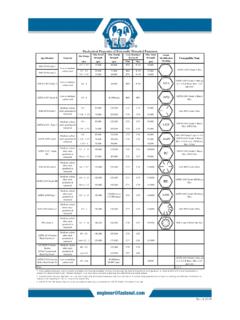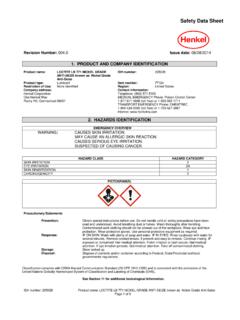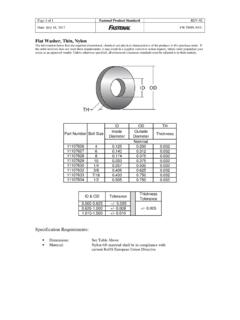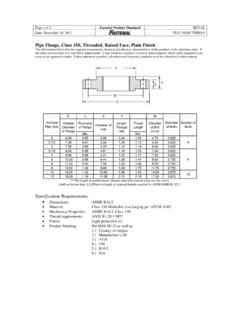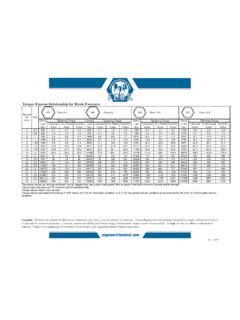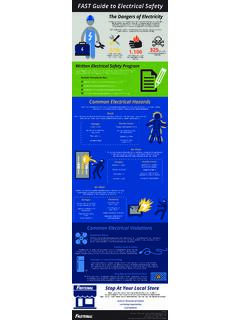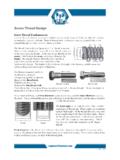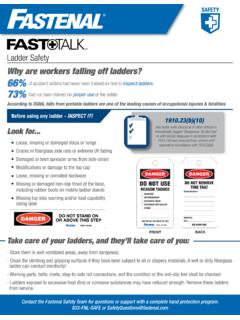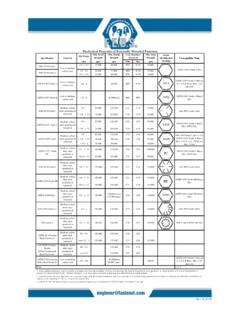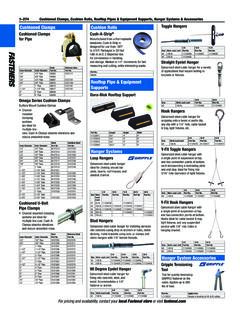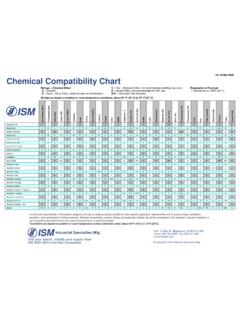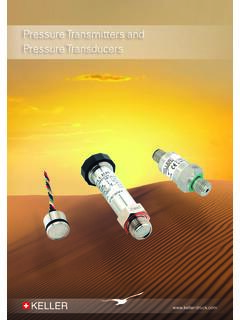Transcription of Corrosion & Corrosion Resistance - Fastenal
1 Rev 3-4-2009 Corrosion & Corrosion Resistance Galvanic Corrosion The issue of Corrosion poses an extreme concern in design. One of the first questions a designer must address when analyzing a fastener application is whether the fastener will be subjected to a corrosive attack during service. It is important to understand that there are several different types of Corrosion including galvanic Corrosion , concentration-cell Corrosion , stress Corrosion , fretting Corrosion , pitting, and oxidation. The most common form of Corrosion is rust (oxidation) associated with steel structures and fasteners, although the effects of corrosive attack can be seen in many other structural materials.
2 Corrosion can be thought of as an electro-chemical action in which one metal is changed into a chemical or simply eaten away. When two metals are in contact with each other in the presence of some electrolyte, the less active metal will act as the cathode and attract electrons from the anode. The anode is the material which corrodes. A simple means of visualizing what is occurring is to consider the action of a battery. If two metals are immersed in an acid, a saline, or an alkaline solution, a battery is formed. This battery produces a flow of electrons between the two metals.
3 The flow of electrons continues as long as the metals exist, the solution remains acidic, saline, or alkaline, and as long as a conductive path connects the two metals. In the case of galvanic Corrosion , the combination of two dissimilar metals with an electrolyte is all that is needed to form a reaction. The use of dissimilar metals in structural design is fairly common, particularly cases where the fastener material is different from the structure being joined. Furthermore, the electrolyte may be present in the form of rain, dew, snow, high humidity, ocean salt spray, or even air pollution.
4 Thus, designers must take into account the reactivity of the metals being joined. All metals have some kind of electrical potential. The Galvanic Series of Metals and Alloys chart above provides a realistic and practical ranking of metallic electrical potentials. The alloys near the bottom are cathodic and unreactive; those at the top are most anodic. The various metals which are grouped together are reasonably compatible when used together; those in different groups may cause a Corrosion Without a barrier of protection, steel will quickly succumb to the effects of Corrosion Galvanic Series of Metals and Alloys + Corroded End (anodic, or increasingly active) Magnesium and Magnesium alloys Zinc Aluminum 1100 Cadmium Aluminum 2024-T4 Iron and Steel Lead Tin Nickel (active) Inconel nickel-chromium alloy (active) Hastelloy Alloy C (active) Brasses (Cu-Zn alloys) Copper Bronzes (Cu-Sn alloys) Copper-nickel alloys Monel (70Ni-30Cu) Nickel (passive) Inconel (80Ni-13Cr-7Fe) 304 Stainless Steel (passive)
5 316 Stainless Steel (passive) Hastelloy Alloy C (passive) Silver Titanium Graphite Gold Platinum - Protected End (cathodic or increasingly inert) Rev 3-4-2009 problem. Some metals, especially those with significant contents of nickel and chromium, are included in the table in both their active and passive conditions. Passivation, ( : surface cleaning and sealing) lowers the metals electrical potential and improves its Corrosion behavior. As the series suggests, steel and aluminum are relatively compatible, but if brass and steel contact, the steel will corrode because it is more anodic than the brass.
6 If brass and aluminum plates are connected by a passivated 304 stainless steel bolt, both the brass and the aluminum will corrode severely where they touch the stainless steel because they are much more anodic than stainless steel. The aluminum plate will corrode more heavily due to it being more anodic to stainless steel than brass is. The aluminum will also corrode where its exposed surface contacts the brass plate because brass is more cathodic. A Plating compatibility Chart is provided below that may be used to aid with fastener selection based on galvanic reaction.
7 Plating compatibility Chart Fastener Metal Base Metal Zinc & Galvanized Steel Aluminum & Aluminum Alloys Steel & Cast Iron Brasses, Coppers, Bronzes & Monel Martensitic Stainless Type 410 Austenitic Stainless Type 302/304, 303, 305 Zinc & Galvanized Steel 1 2 2 3 3 3 Aluminum & Aluminum Alloys 1 1 2 3 Never Recommended 2 Steel & Cast Iron 1, 4 1 1 3 3 2 Brasses, Coppers, Bronzes & Monel 1, 4, 5 1, 5 1, 5 1 1 2 Martensitic Stainless Type 410 1, 4, 5 1, 5 1, 5 1 1 1 Austenitic Stainless Type 302/304, 303, 305 1, 4, 5 1, 5 1, 5 1, 5 1 1 Plating compatibility Chart KEY: 1 The Corrosion of the base metal is not increased by the fastener.
8 2 The Corrosion of the base metal is marginally increased by the fastener. 3 The Corrosion of the base metal is considerably increased by the fastener. 4 The plating on the fastener is rapidly consumed, leaving the bare fastener metal. 5 Corrosion of the fastener is increased by the base metal. Note: Surface treatment and environment can significantly alter activity. 304 Stainless Steel Bolt (Passivated) Aluminum Plate Rev 3-4-2009 Other Types of Corrosion Concentration-cell and pitting Corrosion contrast with galvanic Corrosion in that concentration-cell and pitting require only one metal in the presence of an electrolyte to set up an attack system.
9 This type of Corrosion begins with the creation of a differential in concentration of oxygen at the metal surface (an enclosed bubble of air). This causes a lack of fresh oxygen supply, and in combination with the electrolyte it produces a highly effective localized battery with resultant Corrosion and metal attack. Other Corrosion systems can be equally severe. Common to all systems is the unfortunate fact that Corrosion develops after the structure is put into service. Corrosion protection at design inception should be a key objective of the joint design.
10 One of the first steps in Corrosion protection is to identify the specific anticipated Corrosion exposure in order to control or minimize its consequences in service. An attempt should be made to select fastener materials which are compatible with the structure being joined. One possible consideration is a protective coating or finish for the fastener. Supplemental coatings or finishes may provide additional protection for the entire joint. Fretting Corrosion , aka fretting fatigue, occurs as a result of two materials, under load, when subject to relative motion.
